Summary
An invasive pathogen causing bleeding cankers on beech tree trunks, necrosis on leaves of rhododendrons, pieris and magnolias, and extensive dieback of bilberry.
Disease overview
The novel species Phytophthora kernoviae was first isolated from beech and rhododendron by scientists from Forest Research and the Food and Environment Research Agency (now Fera Science) in 2003. Its likely origins are in the Southern Hemisphere, because it has been found in New Zealand and Chile.
Our research into this highly aggressive pathogen shows it attacks leaves, buds and shoots of under-storey rhododendron in woodlands, as well as ornamental garden plant species. Woodland trees such as beech can also be at risk of infection if they are growing within a few metres of affected rhododendron because of the number of spores released from infected foliage of this shrub.
This resource provides information from our research about the distribution and spread of this infection. Our guide to symptoms will help you to identify infected rhododendrons so you can take precautionary action to destroy these plants.
Disease details
- P. kernoviae is a fungus-like pathogen which affects the aerial parts of the trees and shrubs.
- It causes leaf necrosis and/or stem dieback in shrubs and bushes and some tree species.
- Its principal host is rhododendron, mainly R. ponticum.
- Bilberry (V. myrtillus) is also highly susceptible and suffers extensive dieback.
- It attacks the inner bark of European beech (Fagus sylvatica) and very occasionally English or pedunculate oak (Quercus robur) leading to bleeding cankers.
- Our research suggests that only trees in close proximity to affected shrub vegetation such as rhododendron are at risk from infection, and that infected trees are not contagious and can even recover from infection.
- Several garden ornamentals such as Magnolia, Pieris and Drimys species, can suffer from leaf and shoot blight.
Incidence and distribution
- It is found mainly in south-west England sites, where the weather favours it and allows it to be particularly aggressive and virulent
- It is occasionally found in other locations, including Wales and Scotland, typically in individual plants or as outbreaks in rhododendron.
- It has infected thousands of rhododendrons and heathland bilberry plants in Cornwall.
- It spread to a few woodland tree species (especially beech) and ornamental plants, usually found in close proximity to infected rhododendron.
Symptoms
- Leaf necrosis and/or shoot dieback in susceptible plants and shrubs
- Bleeding cankers in trees caused by necrosis of inner bark tissue
- Leaf spot in many Magnolia species
These can also be general symptoms caused by some other plant pathogens, including the more widespread Phytophthora ramorum in rhododendron. Please consult our symptoms and diagnosis page for help and advice on identifying P. kernoviae infections in plants and trees. A fact sheet is also available from FERA.
Our Tree Health Diagnostic and Advisory Service offers laboratory-based infection diagnosis. Phytophthora screening provides an accurate diagnosis to support your management decisions and obligations.
Disease management
There is no cure for P. kernoviae infection. Therefore to prevent or limit the spread of disease, owners and managers should consider removing and destroying all infected plants, following the management procedures advised for P. ramorum.
Our research
Our scientists first isolated, identified and characterised Phytophthora kernoviae as a new species in 2003. Our research, funded by Defra and the Forestry Commission’s Phytophthora Programme, investigated the organism’s method of spread, the process of infection, and disease management strategies.
Our work covers or has covered:
- effective diagnosis and detection of Phytophthora pathogens;
- the distribution and impact of recently introduced Phytophthoras, such as Phytophthora ramorum, P. kernoviae and P. lateralis, to trees in Britain;
- susceptibility of forest and woodland tree species to P. ramorum and P. kernoviae;
- extent of variation in some of the recently arrived Phytophthora species to identify the possible origins, entry pathways and potential for genetic change;
- understanding the infection process and disease development in relation to key variables (e.g. host availability, inoculum production and climate); and
- how Phytophthora pathogens spread in natural and seminatural environments.
Our research has led to the following publications:
We are among the leading research institutes looking into Phytophthora organisms and the diseases they cause, including Phytophthora austrocedri on juniper, Phytophthora on alder, Phytophthora lateralis and Phytophthora ramorum, the cause of ramorum disease, sometimes known as sudden larch death when it occurs on larch trees (species in the Larix genus).
Related resources
- Detailed characterisation of the new species
- Progress in Research on Phytophthora Diseases of Forest Trees
Distribution of Phytophthora kernoviae
Phytophthora kernoviae: Origins, incidence and distribution
Mostly found in south west England, but confirmed infections in many plant species across the UK.
Origins
Phytophthora kernoviae, first isolated from a beech tree canker sample by Forest Research scientists, is yet another invasive Phytophthora found to be causing damage and mortality to trees in the UK in the past decade. Related pathogens include the hybrid alder P. alni, and the ‘sudden oak death’ pathogen P. ramorum, P. lateralis and P. austrocedrae.
Most of these Phytophthoras were unknown to science until recently and are likely to have been introduced via international plant trade.
The geographical origins of P. kernoviae are still debated. It is a pathogen that grows best at around 18 °C with an upper limit of 26 °C which suggests it is adapted to a temperate climate. This could indicate a possible origin in the temperate forests of the eastern Himalaya, China or Taiwan. Another possible origin is Patagonia, because of its infection of Chilean hazelnut (Gevuina avellana). More recent reports from New Zealand and Chile also suggest a Southern Hemisphere origin for this Phytophthora species.
UK distribution
Most sites affected with Phytophthora kernoviaeare located in south west England. They include woodland, open heath bilberry sites and occasional reports of isolated infections on ornamental shrubs and trees in gardens.
Incidence in rhododendron and bilberry (UK)
Rhododendron (typically R. ponticum) is the primary host for P. kernoviae. Thousands of these plants have been infected, mainly in south west England where the pathogen is probably more virulent to rhododendron than P. ramorum.
Our research shows that bilberry (Vaccinium myrtillus) is also highly susceptible to Phytophthora kernoviae; and infection among plants spreads through open heath and causes extensive dieback.
Incidence in trees (UK)
Our research and monitoring at infection sites suggests that trees in close proximity (<5 m) to diseased rhododendron are at risk of infection through the transfer of spores from the infected leaves of the rhododendron plants.
A few hundred European beech trees (Fagus sylvatica) have been infected in this way, mainly in the south west. It was also found infecting two oak (Quercus robur) trees. Forest Research first isolated P.kernoviae from a beech bleeding canker in 2003.
On infected sites Phytophthora kernoviae Infection has been confirmed in the following species:
- Winter’s bark (Drimys winterii)
- Magnolia species
- Holm oak (Quercus ilex)
A small number (five or fewer trees) of other tree species have also been infected:
- Sweet chestnut (Castanea sativa)
- Michelia doltsopa
- Cherry laurel (Prunus laurocerasus)
- Podocarpus salignus
There are reports of infection in a tulip tree (Liriodendron tulipifera), a Chilean hazelnut (Gevuina avellana) and a single ivy plant (Hedera helix).
P. kernoviae around the world
Apart from the UK, the Republic of Ireland is the only other country in Europe where Phytophthora kernoviae has been found.
In March 2006, the New Zealand Ministry of Agriculture and Forestry announced that P. kernoviae had been detected in two separate localities on the North Island in New Zealand. At one of the sites it was infecting the shoots and fruit of cherimoya or custard apple (Annona cherimola) in an orchard, at the other site – the Trounson Kauri Park – it was isolated from soil under Pinus radiata. Annona cherimola is an exotic species from South America. In 2014, Phytophthora kernoviae was also reported from Chile infecting Drimys winterii (winter’s bark).
These reports of Phytophthora kernoviae in the Southern Hemisphere, and findings of disease in Southern Hemisphere hosts in the UK (Podocarpus, Drimys and Gevuina), all point to a possible origin from this part of the world.
Phytophthora kernoviae outbreaks in UK
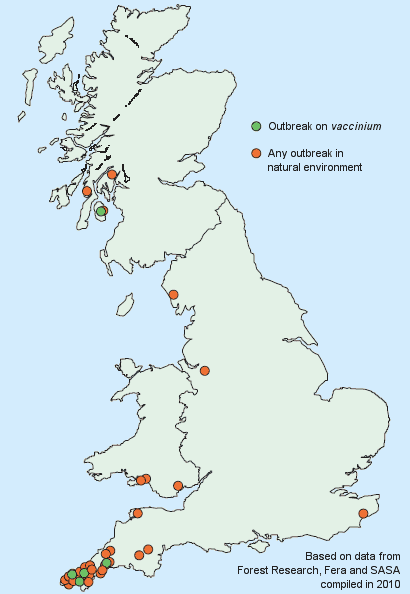
Phytophthora kernoviae: Discovery
Discovered by Forest Research scientists from a beech bleeding canker in 2003
During surveys in the southwest of England in November 2003, a new species of Phytophthora, later named Phytophthora kernoviae, was discovered by Professor Clive Brasier, Emeritus Mycologist at Forest Research. It was isolated from a beech tree with bleeding canker.
At the same time researchers from the Food and Environment Research Agency (FERA) isolated an identical organism from infected rhododendrons.
Since the discovery, our scientists have been involved in extensive studies and the characterisation of this novel organism, given the name kernoviae, derived from Kernow, the Cornish name for Cornwall.
Further reading
- Research paper: Phytophthora kernoviae sp. nov., an invasive pathogen
- Management of Phytophthora kernoviae and P. ramorum in south west England. Phytophthoras in Forests and Natural Ecosystems (pages 177-183)
- Fichtner et al. (2012). Infectivity and sporulation potential of Phytophthora kernoviae to select North American native plants. Plant Pathology.
Symptoms of Phytophthora kernoviae
Phytophthora kernoviae: Symptoms and diagnosis
Leaf and stem necrosis and dieback in rhododendron and other shrubs. Bleeding cankers in trees.
Typical symptoms: leaf necrosis
Infected shoots (buds and young stems) and leaves of plants become necrotic. Entire tufts of foliage often wilt at the end of the shoots and then desiccate. Leaf necrosis occurs in many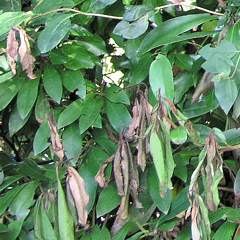 infected species. In rhododendron, infected leaves often show blackening down the mid-vein and stalk (IMAGE: CIMG0861 severe dieback of rhododendron caused by P. kernoviae).
infected species. In rhododendron, infected leaves often show blackening down the mid-vein and stalk (IMAGE: CIMG0861 severe dieback of rhododendron caused by P. kernoviae).
Shoot tip dieback and leaf wilt of Rhododendron ponticum infected with P. kernoviae,
Cornwall, UK, 9 Aug 2005
Beech and oak: bleeding canker
Bark invasion by P. kernoviae In European beech (Fagus sylvatica) kills extensive areas of inner bark, often extending 10 m or more up the stem. This necrotic zone oozes a black, sticky fluid hence the phrase bleeding canker (IMAGE CIMG0907: Trunk of beech tree with bleeding cankers caused by Phytophthora kernoviae). Two English oak trees (Quercus robur) have also picked up infections from neighbouring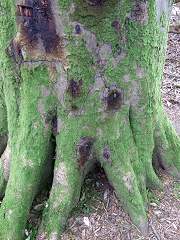 host rhododendron bushes. These trees have also developed bleeding cankers.
host rhododendron bushes. These trees have also developed bleeding cankers.
Our monitoring of infected trees suggests that the bleeding cankers are not contagious, and the trees may recover from infection.
Bleeding canker caused by P. kernoviae on beech,
May 2006
Bilberry (Vaccinium myrtillus)
Studies by Forest Research found P. kernoviae infecting plants of bilberry (Vaccinium myrtillus) in oak woodland and also open heathland in Cornwall. Bilberry is a native plant to Britain. It grows in lowland and upland heathlands, but can also be found in some woodlands, grasslands and peat bogs.
Symptoms include stem blackening and necrotic leaves, although the affected leaves are quickly shed.
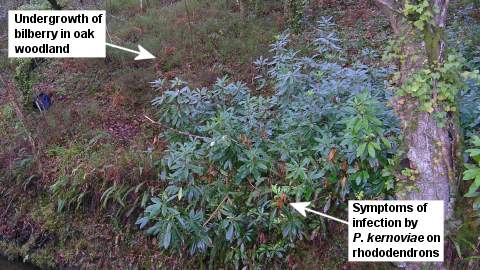
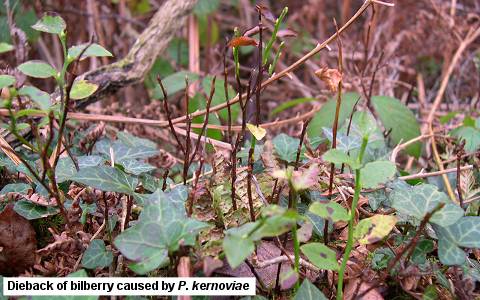
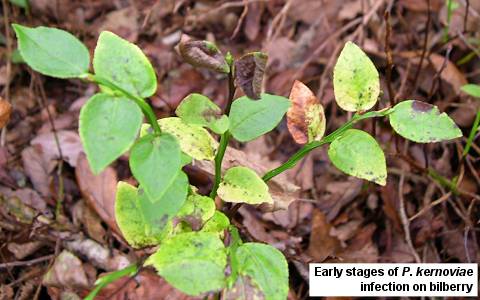
Magnolia: leaf spot
A wide range of different magnolia species and hybrids have been infected by P. kernoviae, picking up the infection from affected rhododendrons in the same garden. Our research shows that P. kernoviae can persist on infected tissues over winter a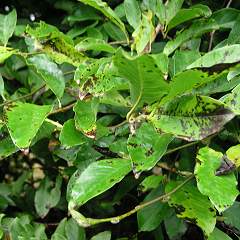 nd then re-infect the new flowers and leaves that are formed the following spring. The most common symptom in Magnolia is leaf spot; some species also show bud blast and blossom blight (IMAGE: P kernoviae infection of magnolia foliage).
nd then re-infect the new flowers and leaves that are formed the following spring. The most common symptom in Magnolia is leaf spot; some species also show bud blast and blossom blight (IMAGE: P kernoviae infection of magnolia foliage).
Magnolia tree foliage infected with P. kernoviae,
Cornwall, UK, 22 Oct 2004
Diagnosis
The general symptoms of P. kernoviae infection make it difficult to diagnose without laboratory testing. If you find a rhododendron or tree exhibiting these symptoms, please contact our Tree Health Diagnostic and Advisory Service. We may recommend you send us leaf or tissue samples so we can screen for P. kernoviae, P. ramorum and other possible pathogens.
More information
- For more information about symptoms download the Forestry Commission-Fera Fact Sheet
If you suspect a plant has P. kernoviae or a similar infection, please report your sighting using TreeAlert.
Magnolia species found naturally infected by Phytophthora kernoviae in Britain
| Latin name | Common name | Native range | Symptom expression |
|
|---|---|---|---|---|
| Magnolia species | Magnolia amoena | – | China | Leaf spot |
| Magnolia cylindrica | Yellow mountain magnolia | China | Leaf spot and bud blast | |
| Magnolia delavayi | Chinese evergreen magnolia | China | Leaf blight | |
| Magnolia kobus | Kobus magnolia | Japan | Leaf spot and bud base death | |
| Magnolia liliiflora | Lily magnolia | China | Leaf spot | |
| Magnolia mollicomata ‘Lanarth’ | – | China | Leaf spot and bud blast | |
| Magnolia salicifolia | Willow-leafed magnolia | Japan | Leaf spot | |
| Magnolia sargentiana | Sargent’s magnolia | China | Leaf spot | |
| Magnolia sprengeri | Sprenger’s magnolia | China | Leaf spot | |
| Magnolia stellata | Star magnolia | Japan | Leaf spot | |
| Magnolia wilsonii | Wilson’s magnolia | China | Leaf necrosis and blossom blight | |
| Magnolia hybrids | Magnolia x soulangeana | Saucer magnolia | Japan | Leaf spot |
| Magnolia x brooklynensis (M. acuminata x M. liliiflora) | Evamaria cucumber tree | Leaf spot | ||
| Magnolia Gresham hybrid ‘Joe McDaniel’ (M. soulangeana x M. veitchii) | – | Leaf spot | ||
| Magnolia Gresham hybrid ‘Sayonara’ (M. soulangeana x M. veitchii) | Sayonara magnolia | Japan | Leaf spot | |
| Magnolia x lobneri ‘Leonard Messel’ (M. soulangeana x M. veitchii) | Leonard Messel magnolia | Japan | Leaf spot, blossom blight and bud blast |
Publications, reports and posters about Phytophthora kernoviae
Phytophthora kernoviae: Resources including publications, reports and posters
A bibliography of research on Phytophthora kernoviae
Publications
Brasier, C., Denman, S., Brown, A. and Webber, J. (2004). Sudden oak death (Phytophthora ramorum) discovered on trees in Europe. Mycological Research 108, 1108-1110.
Brasier, C.M., Beales, P.A., Kirk, S.A., Denman, S. and Rose, J. (2005). Phytophthora kernoviae sp. nov., and invasive pathogen causing bleeding stem lesions on forest trees and foliar necrosis of ornamentals in the UK. Mycological Research 109, 853-859.
Brown, A., Brasier, C., Denman, S. Rose, J., Kirk, S., and Webber, J. (2006). Tree hosts as aerial Phytophthora infections with particular reference to P. ramorum and P. kernoviae at two UK survey sites. In: Progress in Research on Phytophthora Diseases of Forest Trees (Proceedings of the IUFRO conference on Phytophthora pathogens of trees, Freising, 11–17 September 2004), eds. C. Brasier, T. Jung and W. Oβwald, pp. 122-125.
Brown, A., Brasier, C. and Webber, J. (2006). Aetiology and distribution of Phytophthora kernoviae and P. ramorum stem lesions on European beech in southwest England. In: Progress in Research on Phytophthora Diseases of Forest Trees (Proceedings of the IUFRO conference on Phytophthora pathogens of trees, Freising, 11–17 September 2004), eds. C. Brasier, T. Jung and W. Oβwald, pp. 139-141.
Brown, A. V. and Brasier, C. M. (2007). Colonization of tree xylem by Phytophthora ramorum, P. kernoviae and other Phytophthora species. Plant Pathology 56, 227-241
Deman, S., Kirk, S.A., Brasier, C.M. and Webber, J.F. (2005). In vitro Leaf Inoculation Studies as an Indication of Tree Foliage Susceptibility to Phytophthora ramorum in the UK. Plant Pathology 54, 512–521.
Denman, S., Kirk, S.A., Whybrow, A., Orton, E. and Webber, J.F. (2006). Phytophthora kernoviae and P. ramorum: host susceptibility and sporulation potential on foliage of susceptible trees. EPPO Bulletin 36 (2), 373–376.
Denman, S., Kirk, S.A., Moralejo, E.and Webber J.F. (2009). Phytophthora ramorum and P. kernoviae on naturally infected asymptomatic foliage. EPPO Bulletin 39, 105-111.
Fichtner, E. J., Rizzo, D. M., Kirk, S. A. and Webber, J. F. (2011). Root Infections May Challenge Management of Invasive Phytophthora spp. in U.K. Woodlands. Plant Disease 95(1), 13-18.
Fichtner, E. J., Rizzo, D. M., Kirk, S. A. and Webber, J. F. (2012), Infectivity and sporulation potential of Phytophthora kernoviae to select North American native plants. Plant Pathology, 61: 224–233. DOI:10.1111/j.1365-3059.2011.02506.x
Webber, J. (2009). Management of Phytophthora kernoviae and P. ramorum in southwest England. In: Frankel SJ, Kliejunas JT, Palmieri KM, eds. Proceedings of the Sudden Oak Death Third Science Symposium, pp. 177-183. General Technical Report PSW-GTR-214. Albany, CA, USA: Pacific Southwest Research Station, US Forest Service.
Reports
- Denman, S. (2007). Assessment of chemical treatments (PDF-478K)
Other resources
